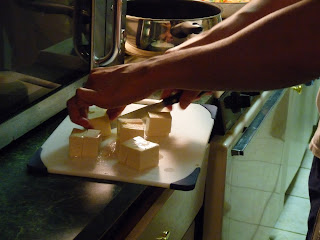This recipe is another of my mother's. She used to make it in winter, and I have fond memories of the familiar grind of her food processor whirring away one batch at a time. That thing is 10 years older than I am and is still working as well as ever. When Barry and I got married this Spring I put a food processor on our registry for the specific purpose of making this soup (among other things), and am sad to say this is the first time I've made it. But the food processor, as well as the many other marvelous registry-acquired kitchen tools have all been wonderful, and I have absolutely loved using every one of them. So a heartfelt thanks to the sweet friends and family who got us things for the kitchen. This year has been busy and downtime is a sparse commodity, but thanks to your gifts I can make time to relax every night as I make dinner. Thank you
With Barry on call tonight and the apartment now mostly clean, I figured I would break out the camera and share this great recipe with the world. Here's what you need:
Ingredients
1 large or 2 small broccoli crowns
1 potato
1 large can of chicken broth, or 1 regular can each of chicken and beef broth
1 tablespoon butter
1 tablespoon flour
1-2 teaspoons salt
1 teaspoon curry
1. To begin, rinse the broccoli and cut into florets. You can also peel and chop the stems, which I recommend since they have a slightly different flavor from the "tree" parts. Broccoli is a great example of the fractal geometry of nature. Just looking at it tells you nothing of the size, since the pattern which underlies the form is repeated at multiple levels. Beautiful!


2. Cook the broccoli with a cup of water over medium heat for about 10 minutes. Use a steamer basket if you like, but you don't need one. I like them because they keep your veggies from getting waterlogged and you can use them to transport everything when you're done.
3. Peel and chop the potato and boil for 10 - 15 minutes in salted water. I used 2 but ended up with much more than I needed. Drain and set aside.

4. Use the food processor to pulverize the broccoli and potatoes, but process them separately. You can add a little chicken broth to make the process go faster.

5. Next is my favorite step, making a roux (pronounced 'roo'). A roux is the first step in any gravy, sauce or soup recipe, and acts as a thickening agent. In a pan over medium heat melt 1 tablespoon butter and add to it one tablespoon of flour, stirring regularly with a whisk. Now a brief aside... I absolutely love kitchen gadgets because each one is so perfectly suited to a particular purpose. Take this whisk for example. Not only is it great at mixing things evenly (as are all whisks), but it's coated in silicon so that it doesn't scratch your teflon. It may seem unnecessary to own 5 different types of whisks, but to each his own. This one happens to be another awesome wedding present :)

6. After stirring the roux for a minute or two, add about half a cup of broth and continue whisking. When the broth starts to thicken you can add the broccoli puree and another half cup of broth. Add the pureed potato by spoonfuls and continue whisking. Keep adding the broth to keep a smooth consistency.

























































